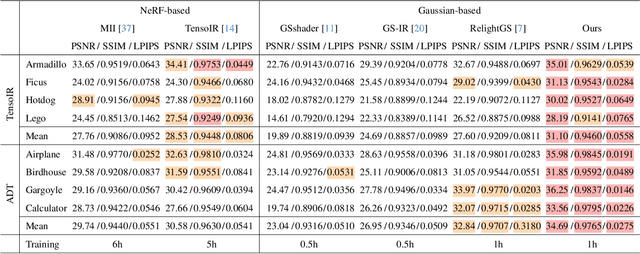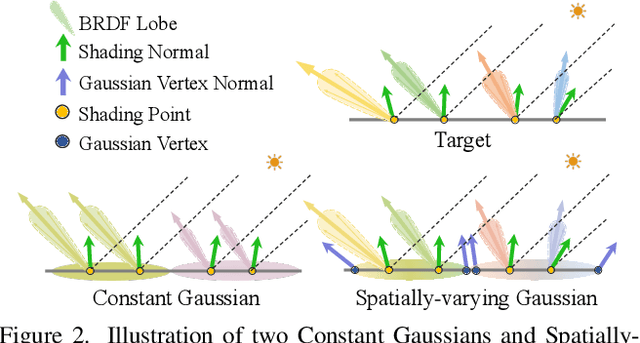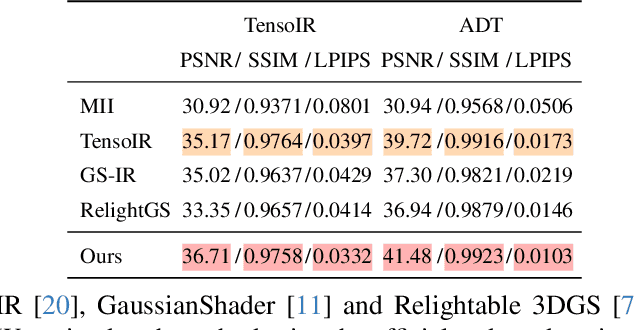Beibei Wang
HiMat: DiT-based Ultra-High Resolution SVBRDF Generation
Aug 12, 2025



Abstract:Creating highly detailed SVBRDFs is essential for 3D content creation. The rise of high-resolution text-to-image generative models, based on diffusion transformers (DiT), suggests an opportunity to finetune them for this task. However, retargeting the models to produce multiple aligned SVBRDF maps instead of just RGB images, while achieving high efficiency and ensuring consistency across different maps, remains a challenge. In this paper, we introduce HiMat: a memory- and computation-efficient diffusion-based framework capable of generating native 4K-resolution SVBRDFs. A key challenge we address is maintaining consistency across different maps in a lightweight manner, without relying on training new VAEs or significantly altering the DiT backbone (which would damage its prior capabilities). To tackle this, we introduce the CrossStitch module, a lightweight convolutional module that captures inter-map dependencies through localized operations. Its weights are initialized such that the DiT backbone operation is unchanged before finetuning starts. HiMat enables generation with strong structural coherence and high-frequency details. Results with a large set of text prompts demonstrate the effectiveness of our approach for 4K SVBRDF generation. Further experiments suggest generalization to tasks such as intrinsic decomposition.
WeatherDiffusion: Weather-Guided Diffusion Model for Forward and Inverse Rendering
Aug 09, 2025Abstract:Forward and inverse rendering have emerged as key techniques for enabling understanding and reconstruction in the context of autonomous driving (AD). However, complex weather and illumination pose great challenges to this task. The emergence of large diffusion models has shown promise in achieving reasonable results through learning from 2D priors, but these models are difficult to control and lack robustness. In this paper, we introduce WeatherDiffusion, a diffusion-based framework for forward and inverse rendering on AD scenes with various weather and lighting conditions. Our method enables authentic estimation of material properties, scene geometry, and lighting, and further supports controllable weather and illumination editing through the use of predicted intrinsic maps guided by text descriptions. We observe that different intrinsic maps should correspond to different regions of the original image. Based on this observation, we propose Intrinsic map-aware attention (MAA) to enable high-quality inverse rendering. Additionally, we introduce a synthetic dataset (\ie WeatherSynthetic) and a real-world dataset (\ie WeatherReal) for forward and inverse rendering on AD scenes with diverse weather and lighting. Extensive experiments show that our WeatherDiffusion outperforms state-of-the-art methods on several benchmarks. Moreover, our method demonstrates significant value in downstream tasks for AD, enhancing the robustness of object detection and image segmentation in challenging weather scenarios.
Experience Paper: Scaling WiFi Sensing to Millions of Commodity Devices for Ubiquitous Home Monitoring
Jun 04, 2025Abstract:WiFi-based home monitoring has emerged as a compelling alternative to traditional camera- and sensor-based solutions, offering wide coverage with minimal intrusion by leveraging existing wireless infrastructure. This paper presents key insights and lessons learned from developing and deploying a large-scale WiFi sensing solution, currently operational across over 10 million commodity off-the-shelf routers and 100 million smart bulbs worldwide. Through this extensive deployment, we identify four real-world challenges that hinder the practical adoption of prior research: 1) Non-human movements (e.g., pets) frequently trigger false positives; 2) Low-cost WiFi chipsets and heterogeneous hardware introduce inconsistencies in channel state information (CSI) measurements; 3) Motion interference in multi-user environments complicates occupant differentiation; 4) Computational constraints on edge devices and limited cloud transmission impede real-time processing. To address these challenges, we present a practical and scalable system, validated through comprehensive two-year evaluations involving 280 edge devices, across 16 scenarios, and over 4 million motion samples. Our solutions achieve an accuracy of 92.61% in diverse real-world homes while reducing false alarms due to non-human movements from 63.1% to 8.4% and lowering CSI transmission overhead by 99.72%. Notably, our system integrates sensing and communication, supporting simultaneous WiFi sensing and data transmission over home WiFi networks. While focused on home monitoring, our findings and strategies generalize to various WiFi sensing applications. By bridging the gaps between theoretical research and commercial deployment, this work offers practical insights for scaling WiFi sensing in real-world environments.
CSI-Bench: A Large-Scale In-the-Wild Dataset for Multi-task WiFi Sensing
May 28, 2025



Abstract:WiFi sensing has emerged as a compelling contactless modality for human activity monitoring by capturing fine-grained variations in Channel State Information (CSI). Its ability to operate continuously and non-intrusively while preserving user privacy makes it particularly suitable for health monitoring. However, existing WiFi sensing systems struggle to generalize in real-world settings, largely due to datasets collected in controlled environments with homogeneous hardware and fragmented, session-based recordings that fail to reflect continuous daily activity. We present CSI-Bench, a large-scale, in-the-wild benchmark dataset collected using commercial WiFi edge devices across 26 diverse indoor environments with 35 real users. Spanning over 461 hours of effective data, CSI-Bench captures realistic signal variability under natural conditions. It includes task-specific datasets for fall detection, breathing monitoring, localization, and motion source recognition, as well as a co-labeled multitask dataset with joint annotations for user identity, activity, and proximity. To support the development of robust and generalizable models, CSI-Bench provides standardized evaluation splits and baseline results for both single-task and multi-task learning. CSI-Bench offers a foundation for scalable, privacy-preserving WiFi sensing systems in health and broader human-centric applications.
DeepCPD: Deep Learning Based In-Car Child Presence Detection Using WiFi
May 13, 2025



Abstract:Child presence detection (CPD) is a vital technology for vehicles to prevent heat-related fatalities or injuries by detecting the presence of a child left unattended. Regulatory agencies around the world are planning to mandate CPD systems in the near future. However, existing solutions have limitations in terms of accuracy, coverage, and additional device requirements. While WiFi-based solutions can overcome the limitations, existing approaches struggle to reliably distinguish between adult and child presence, leading to frequent false alarms, and are often sensitive to environmental variations. In this paper, we present DeepCPD, a novel deep learning framework designed for accurate child presence detection in smart vehicles. DeepCPD utilizes an environment-independent feature-the auto-correlation function (ACF) derived from WiFi channel state information (CSI)-to capture human-related signatures while mitigating environmental distortions. A Transformer-based architecture, followed by a multilayer perceptron (MLP), is employed to differentiate adults from children by modeling motion patterns and subtle body size differences. To address the limited availability of in-vehicle child and adult data, we introduce a two-stage learning strategy that significantly enhances model generalization. Extensive experiments conducted across more than 25 car models and over 500 hours of data collection demonstrate that DeepCPD achieves an overall accuracy of 92.86%, outperforming a CNN baseline by a substantial margin (79.55%). Additionally, the model attains a 91.45% detection rate for children while maintaining a low false alarm rate of 6.14%.
VistaDepth: Frequency Modulation With Bias Reweighting For Enhanced Long-Range Depth Estimation
Apr 22, 2025Abstract:Monocular depth estimation (MDE) aims to predict per-pixel depth values from a single RGB image. Recent advancements have positioned diffusion models as effective MDE tools by framing the challenge as a conditional image generation task. Despite their progress, these methods often struggle with accurately reconstructing distant depths, due largely to the imbalanced distribution of depth values and an over-reliance on spatial-domain features. To overcome these limitations, we introduce VistaDepth, a novel framework that integrates adaptive frequency-domain feature enhancements with an adaptive weight-balancing mechanism into the diffusion process. Central to our approach is the Latent Frequency Modulation (LFM) module, which dynamically refines spectral responses in the latent feature space, thereby improving the preservation of structural details and reducing noisy artifacts. Furthermore, we implement an adaptive weighting strategy that modulates the diffusion loss in real-time, enhancing the model's sensitivity towards distant depth reconstruction. These innovations collectively result in superior depth perception performance across both distance and detail. Experimental evaluations confirm that VistaDepth achieves state-of-the-art performance among diffusion-based MDE techniques, particularly excelling in the accurate reconstruction of distant regions.
SVG-IR: Spatially-Varying Gaussian Splatting for Inverse Rendering
Apr 09, 2025



Abstract:Reconstructing 3D assets from images, known as inverse rendering (IR), remains a challenging task due to its ill-posed nature. 3D Gaussian Splatting (3DGS) has demonstrated impressive capabilities for novel view synthesis (NVS) tasks. Methods apply it to relighting by separating radiance into BRDF parameters and lighting, yet produce inferior relighting quality with artifacts and unnatural indirect illumination due to the limited capability of each Gaussian, which has constant material parameters and normal, alongside the absence of physical constraints for indirect lighting. In this paper, we present a novel framework called Spatially-vayring Gaussian Inverse Rendering (SVG-IR), aimed at enhancing both NVS and relighting quality. To this end, we propose a new representation-Spatially-varying Gaussian (SVG)-that allows per-Gaussian spatially varying parameters. This enhanced representation is complemented by a SVG splatting scheme akin to vertex/fragment shading in traditional graphics pipelines. Furthermore, we integrate a physically-based indirect lighting model, enabling more realistic relighting. The proposed SVG-IR framework significantly improves rendering quality, outperforming state-of-the-art NeRF-based methods by 2.5 dB in peak signal-to-noise ratio (PSNR) and surpassing existing Gaussian-based techniques by 3.5 dB in relighting tasks, all while maintaining a real-time rendering speed.
MSNGO: multi-species protein function annotation based on 3D protein structure and network propagation
Mar 29, 2025Abstract:Motivation: In recent years, protein function prediction has broken through the bottleneck of sequence features, significantly improving prediction accuracy using high-precision protein structures predicted by AlphaFold2. While single-species protein function prediction methods have achieved remarkable success, multi-species protein function prediction methods are still in the stage of using PPI networks and sequence features. Providing effective cross-species label propagation for species with sparse protein annotations remains a challenging issue. To address this problem, we propose the MSNGO model, which integrates structural features and network propagation methods. Our validation shows that using structural features can significantly improve the accuracy of multi-species protein function prediction. Results: We employ graph representation learning techniques to extract amino acid representations from protein structure contact maps and train a structural model using a graph convolution pooling module to derive protein-level structural features. After incorporating the sequence features from ESM-2, we apply a network propagation algorithm to aggregate information and update node representations within a heterogeneous network. The results demonstrate that MSNGO outperforms previous multi-species protein function prediction methods that rely on sequence features and PPI networks. Availability: https://github.com/blingbell/MSNGO.
Reliable and Compact Graph Fine-tuning via GraphSparse Prompting
Oct 29, 2024



Abstract:Recently, graph prompt learning has garnered increasing attention in adapting pre-trained GNN models for downstream graph learning tasks. However, existing works generally conduct prompting over all graph elements (e.g., nodes, edges, node attributes, etc.), which is suboptimal and obviously redundant. To address this issue, we propose exploiting sparse representation theory for graph prompting and present Graph Sparse Prompting (GSP). GSP aims to adaptively and sparsely select the optimal elements (e.g., certain node attributes) to achieve compact prompting for downstream tasks. Specifically, we propose two kinds of GSP models, termed Graph Sparse Feature Prompting (GSFP) and Graph Sparse multi-Feature Prompting (GSmFP). Both GSFP and GSmFP provide a general scheme for tuning any specific pre-trained GNNs that can achieve attribute selection and compact prompt learning simultaneously. A simple yet effective algorithm has been designed for solving GSFP and GSmFP models. Experiments on 16 widely-used benchmark datasets validate the effectiveness and advantages of the proposed GSFPs.
RNG: Relightable Neural Gaussians
Sep 29, 2024



Abstract:3D Gaussian Splatting (3DGS) has shown its impressive power in novel view synthesis. However, creating relightable 3D assets, especially for objects with ill-defined shapes (e.g., fur), is still a challenging task. For these scenes, the decomposition between the light, geometry, and material is more ambiguous, as neither the surface constraints nor the analytical shading model hold. To address this issue, we propose RNG, a novel representation of relightable neural Gaussians, enabling the relighting of objects with both hard surfaces or fluffy boundaries. We avoid any assumptions in the shading model but maintain feature vectors, which can be further decoded by an MLP into colors, in each Gaussian point. Following prior work, we utilize a point light to reduce the ambiguity and introduce a shadow-aware condition to the network. We additionally propose a depth refinement network to help the shadow computation under the 3DGS framework, leading to better shadow effects under point lights. Furthermore, to avoid the blurriness brought by the alpha-blending in 3DGS, we design a hybrid forward-deferred optimization strategy. As a result, we achieve about $20\times$ faster in training and about $600\times$ faster in rendering than prior work based on neural radiance fields, with $60$ frames per second on an RTX4090.
 Add to Chrome
Add to Chrome Add to Firefox
Add to Firefox Add to Edge
Add to Edge